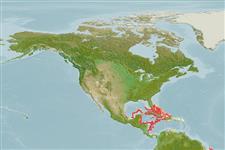>
Ovalentaria/misc (Various families in series Ovalentaria) >
Grammatidae (Basslets)
Etymology: Lipogramma: Name formed from 'lipo' for 'without' and 'gramma' for 'a line of text', referring to the absence of a well-developed lateral line.; robinsi: Named after the prominent ichthyologist Dr. C. Richard Robins..
Environment: milieu / climate zone / depth range / distribution range
Ökologie
seewasser demersal; tiefenbereich 180 - 290 m (Ref. 26884). Deep-water
Western Central Atlantic: East coast of Glover Reef in Belize and off Riding Rock, San Salvador, Bahamas. Probably more widely distributed in the area (Ref. 51269).
Size / Gewicht / Alter
Maturity: Lm ? range ? - ? cm
Max length : 2.2 cm SL Männchen/unbestimmt; (Ref. 26884)
Inhabit deep neritic and epibathyal zones on sedimentary substrates.
Life cycle and mating behavior
Maturities | Fortpflanzung | Spawnings | Egg(s) | Fecundities | Larven
Gilmore, R.G., 1997. Lipogramma robinsi, a new basslet from the tropical western Atlantic, with descriptive and distributional notes on L. flavescens and L. anabantoides (Perciformes: Grammatidae). Bull. Mar. Sci. 60(3):782-788. (Ref. 26884)
IUCN Rote Liste Status (Ref. 130435)
Bedrohung für Menschen
Harmless
Nutzung durch Menschen
Fischereien: nicht kommerziell
Tools
Zusatzinformationen
Download XML
Internet Quellen
Estimates based on models
Preferred temperature (Ref.
123201): 15.8 - 22.7, mean 19.4 °C (based on 16 cells).
Phylogenetic diversity index (Ref.
82804): PD
50 = 0.5003 [Uniqueness, from 0.5 = low to 2.0 = high].
Bayesian length-weight: a=0.01122 (0.00514 - 0.02450), b=3.04 (2.87 - 3.21), in cm total length, based on all LWR estimates for this body shape (Ref.
93245).
Trophic level (Ref.
69278): 3.1 ±0.4 se; based on size and trophs of closest relatives
Fishing Vulnerability (Ref.
59153): Low vulnerability (10 of 100).
